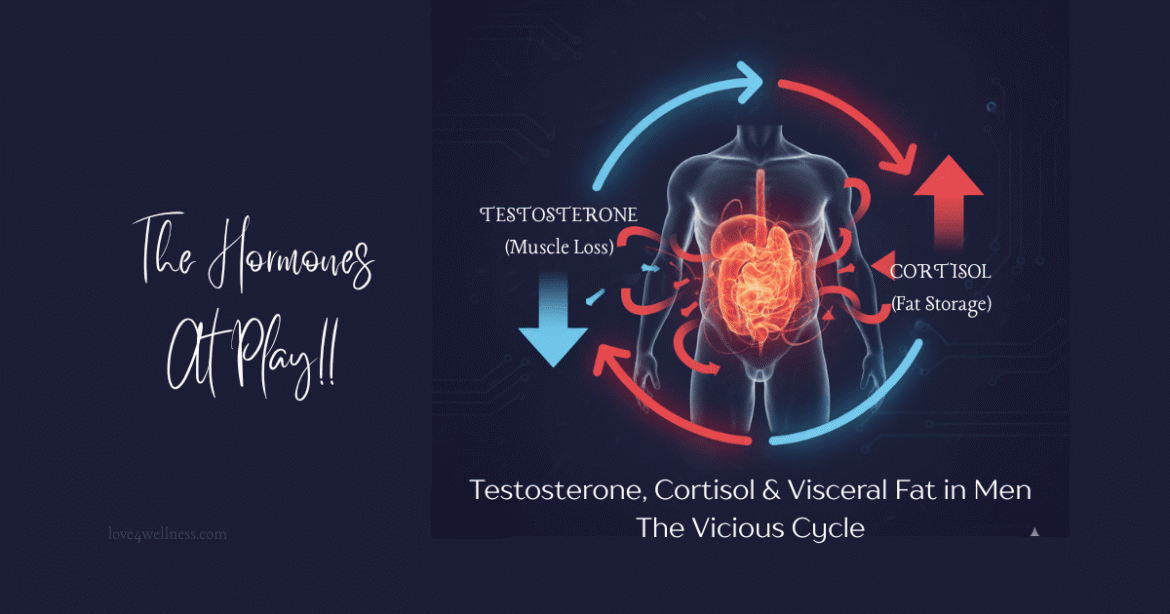The Invisible Steering Wheel
In our last post, we discussed how age naturally slows your metabolism (Why Men Over 40 Put on Abdominal Fat (and What You Can Do About It)). But the real engine behind that slowdown—and a direct driver of belly fat gain—is hormonal change. Think of your hormones as the invisible steering wheel guiding your metabolism. And in men over 40, hormonal changes—especially involving testosterone, cortisol, and visceral fat—create a perfect storm that slows metabolism and increases belly fat.
- Testosterone: The metabolism and muscle builder, which begins a gradual decline.
- Cortisol: The primary stress hormone, which often rises due to modern chronic stress.
Understanding how this hormonal landscape changes is the key to creating a fat-loss strategy that works with your biology, not against it.
#1 Testosterone and Visceral Fat: The Vicious Cycle Explained
Testosterone is the core male hormone, essential for energy, bone health, and libido. But for metabolism, its most important role is maintaining muscle mass.
The Testosterone-Metabolism Link
Muscle is your body’s metabolic furnace; it burns more calories at rest than fat tissue. When testosterone levels are robust, muscle is easily maintained, keeping your metabolism humming.
The Decline
After age 30, a man’s testosterone levels typically drop by 1% to 3% annually. While this is a gradual change, the compounding effect over a decade or two is profound.
The Visceral Fat Vicious Cycle
Visceral fat doesn’t just appear because testosterone drops—it accelerates that drop, trapping you in a self-perpetuating loop.
- Lower T levels reduce muscle mass (sarcopenia).
- Less Muscle leads to a slower metabolic rate, making it easier to gain weight.
- Fat Gain—especially visceral fat—contains an enzyme called Aromatase.
- Aromatase converts active, protective testosterone into estrogen.
- Higher Estrogen/Lower T accelerates the storage of even more visceral fat.
This cycle explains why visceral fat is so stubborn: the fat itself is lowering the very hormone you need to burn it.
Studies show men with low testosterone are 2–3 times more likely to develop high visceral fat levels.
DID YOU KNOW?
#2 Cortisol: The Abdominal Fat Magnet
While testosterone’s decline is gradual, Cortisol—your primary stress hormone—is the immediate, powerful signal that tells your body to store fat.
The Body’s Survival Mechanism
Cortisol is designed for acute, short-term survival (the “fight-or-flight” response). It floods your body with energy (glucose) and signals your body to prepare for stress by storing fat for later. This system is perfect for running from a predator, but terrible for managing a 40-hour work week and a mortgage.
Chronic Stress, Chronic Storage
The pressures of midlife often mean chronic stress—long hours, poor sleep, and financial anxiety. This keeps cortisol levels constantly elevated.
- Visceral Preference: Research shows that when cortisol signals fat storage, it preferentially targets the abdominal region because visceral fat cells have a higher concentration of cortisol receptors than subcutaneous fat cells. It’s an evolutionary quirk: your body is constantly stressed, so it assumes you need an emergency energy reserve right next to your vital organs.
The Double Whammy: When Low Testosterone Meets High Cortisol
The combination of declining testosterone and elevated, persistent cortisol is the perfect hormonal blueprint for the male middle-age spread:
• Low Testosterone → Reduced muscle mass → Slower metabolism → Fewer calories burned daily
• High Cortisol → Higher blood sugar and fat storage → More fat deposited in the abdomen
You are simultaneously burning less and storing more, specifically in the high-risk abdominal area.
Key Takeaway: When testosterone drops and cortisol rises, your body becomes primed to store visceral fat. The secret to reversing it lies in rebuilding muscle, managing stress, and prioritizing recovery.
Take Control of Your Hormonal Health
You cannot stop aging, but you can dramatically influence your hormonal environment. The fight against visceral fat in men is fundamentally a fight to raise your effective testosterone and lower your chronic cortisol. Fortunately, both hormones can be influenced through lifestyle — no quick fixes, but powerful habits that reset your internal balance.
- Fight Aromatase: Commit to Strength Training (Your Action Plan: The Best Exercises to Fight Visceral Fat in Men Over 40) to build muscle and increase your body’s Testosterone-to-Estrogen ratio.
- Lower Cortisol: Prioritize Sleep and adopt Stress Management techniques to break the cycle of chronic cortisol elevation.
In our next post, we will take an even deeper dive into the science of the Cortisol Connection, providing detailed insight into how sleep, nutrition, and stress management directly regulate this powerful fat-storage hormone.
